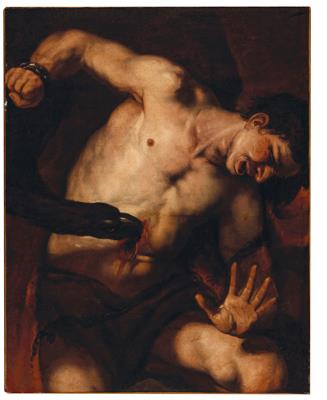Luca Giordano

(Naples 1634–1705)
Prometheus,
oil on canvas, 110 x 87 cm, framed
Provenance:
Private European collection:
where acquired by the present owner
We are grateful to Stefano Causa for confirming the attribution of the present painting and for his help in cataloguing this lot.
The present painting dates to Luca Giordano’s early maturity and the composition is of powerful impact. The subject is Prometheus from Greek mythology, a Titan who stole fire from the Gods in order to give it to mankind. His punishment from Zeus was ferocious: He was chained up at the top of a mountain where an eagle perpetually devoured his liver which continued to grow back, day after day.
There is another slightly larger version of the composition in the National Gallery of Slovenia, Ljubljana, which was formerly attributed to Ribera, until it was restored to Giordano by Federico Zeri in 1992 (inv. no. NG S 2017, 124 x 99 cm). A further two versions are in the Museum of Fine Arts, Budapest (inv. no. 92.6) and in the National Gallery, Warsaw (acc. no. M.Ob.308, 73.5x160 cm) which shows a full-length Prometheus.
The present Prometheus is a previously unpublished work by Giordano. This type of representation is foundational to Baroque art. Illuminated from the left, the Titan’s torso is pushed forward into space, forcing the viewer to bear witness to the spectacle The palette is limited to a narrow range of colours deployed with a virtuosity of rendering. The application of colour is swift and concise. This scene of violence unfolds at the forefront of the picture plane and is seen from a boldly low viewpoint, so that the Titan’s body fills the greater part of the canvas and his open hand appears to break through the picture surface. Prometheus’ features are contorted in pain as he struggles to break free of his chains.
The canvas was probably executed during the middle years of the 1660s, or a little after, when the Giordano had asserted his leadership over the Neapolitan school of painting, and was gaining influence in the Florence, Genoa and Venice.
Giordano’s Prometheus was almost certainly based on studies from life after a studio model, deployed with an approach to realism derived from Caravaggio. As in other works by the Neapolitan painter, Giordano’s response to the antique remains vivid. The subject of the giant who struggles for liberation in vain, is a clear quotation of the celbrated Hellenistic sculpture group, the Laocoön, which was discovered during excavations in Rome in 1506. The work attained great fame and significantly influenced Neapolitan painters of the seventeenth century.
Specialist: Mark MacDonnell
 Mark MacDonnell
Mark MacDonnell
+43 1 515 60 403
mark.macdonnell@dorotheum.at
10.11.2021 - 16:00
- Estimate:
-
EUR 60,000.- to EUR 80,000.-
Luca Giordano
(Naples 1634–1705)
Prometheus,
oil on canvas, 110 x 87 cm, framed
Provenance:
Private European collection:
where acquired by the present owner
We are grateful to Stefano Causa for confirming the attribution of the present painting and for his help in cataloguing this lot.
The present painting dates to Luca Giordano’s early maturity and the composition is of powerful impact. The subject is Prometheus from Greek mythology, a Titan who stole fire from the Gods in order to give it to mankind. His punishment from Zeus was ferocious: He was chained up at the top of a mountain where an eagle perpetually devoured his liver which continued to grow back, day after day.
There is another slightly larger version of the composition in the National Gallery of Slovenia, Ljubljana, which was formerly attributed to Ribera, until it was restored to Giordano by Federico Zeri in 1992 (inv. no. NG S 2017, 124 x 99 cm). A further two versions are in the Museum of Fine Arts, Budapest (inv. no. 92.6) and in the National Gallery, Warsaw (acc. no. M.Ob.308, 73.5x160 cm) which shows a full-length Prometheus.
The present Prometheus is a previously unpublished work by Giordano. This type of representation is foundational to Baroque art. Illuminated from the left, the Titan’s torso is pushed forward into space, forcing the viewer to bear witness to the spectacle The palette is limited to a narrow range of colours deployed with a virtuosity of rendering. The application of colour is swift and concise. This scene of violence unfolds at the forefront of the picture plane and is seen from a boldly low viewpoint, so that the Titan’s body fills the greater part of the canvas and his open hand appears to break through the picture surface. Prometheus’ features are contorted in pain as he struggles to break free of his chains.
The canvas was probably executed during the middle years of the 1660s, or a little after, when the Giordano had asserted his leadership over the Neapolitan school of painting, and was gaining influence in the Florence, Genoa and Venice.
Giordano’s Prometheus was almost certainly based on studies from life after a studio model, deployed with an approach to realism derived from Caravaggio. As in other works by the Neapolitan painter, Giordano’s response to the antique remains vivid. The subject of the giant who struggles for liberation in vain, is a clear quotation of the celbrated Hellenistic sculpture group, the Laocoön, which was discovered during excavations in Rome in 1506. The work attained great fame and significantly influenced Neapolitan painters of the seventeenth century.
Specialist: Mark MacDonnell
 Mark MacDonnell
Mark MacDonnell
+43 1 515 60 403
mark.macdonnell@dorotheum.at
|
Buyers hotline
Mon.-Fri.: 10.00am - 5.00pm
old.masters@dorotheum.at +43 1 515 60 403 |
| Auction: | Old Master Paintings |
| Auction type: | Saleroom auction with Live Bidding |
| Date: | 10.11.2021 - 16:00 |
| Location: | Vienna | Palais Dorotheum |
| Exhibition: | 29.10. - 10.11.2021 |
